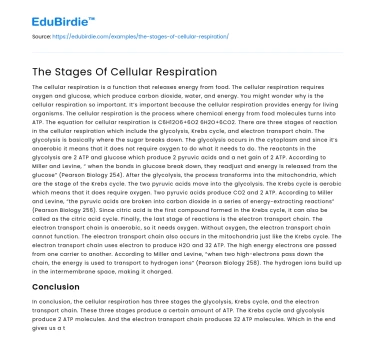The cellular respiration is a function that releases energy from food. The cellular respiration requires oxygen and glucose, which produce carbon dioxide, water, and energy. You might wonder why is the cellular respiration so important. It’s important because the cellular respiration provides energy for living organisms. The cellular respiration is the process where chemical energy from food molecules turns into ATP. The equation for cellular respiration is C6H12O6+6O2 6H2O+6CO2. There are three stages of reaction in the cellular respiration which include the glycolysis, Krebs cycle, and electron transport chain.
The glycolysis is basically where the sugar breaks down. The glycolysis occurs in the cytoplasm and since it’s anaerobic it means that it does not require oxygen to do what it needs to do. The reactants in the glycolysis are 2 ATP and glucose which produce 2 pyruvic acids and a net gain of 2 ATP. According to Miller and Levine, “ when the bonds in glucose break down, they readjust and energy is released from the glucose” (Pearson Biology 254).
Save your time!
We can take care of your essay
- Proper editing and formatting
- Free revision, title page, and bibliography
- Flexible prices and money-back guarantee
After the glycolysis, the process transforms into the mitochondria, which are the stage of the Krebs cycle. The two pyruvic acids move into the glycolysis. The Krebs cycle is aerobic which means that it does require oxygen. Two pyruvic acids produce CO2 and 2 ATP. According to Miller and Levine, “the pyruvic acids are broken into carbon dioxide in a series of energy-extracting reactions” (Pearson Biology 256). Since citric acid is the first compound formed in the Krebs cycle, it can also be called as the citric acid cycle.
Finally, the last stage of reactions is the electron transport chain. The electron transport chain is anaerobic, so it needs oxygen. Without oxygen, the electron transport chain cannot function. The electron transport chain also occurs in the mitochondria just like the Krebs cycle. The electron transport chain uses electron to produce H2O and 32 ATP. The high energy electrons are passed from one carrier to another. According to Miller and Levine, “when two high-electrons pass down the chain, the energy is used to transport to hydrogen ions” (Pearson Biology 258). The hydrogen ions build up in the intermembrane space, making it charged.
Conclusion
In conclusion, the cellular respiration has three stages the glycolysis, Krebs cycle, and the electron transport chain. These three stages produce a certain amount of ATP. The Krebs cycle and glycolysis produce 2 ATP molecules. And the electron transport chain produces 32 ATP molecules. Which in the end gives us a total of 36 ATP molecules.






 Stuck on your essay?
Stuck on your essay?

